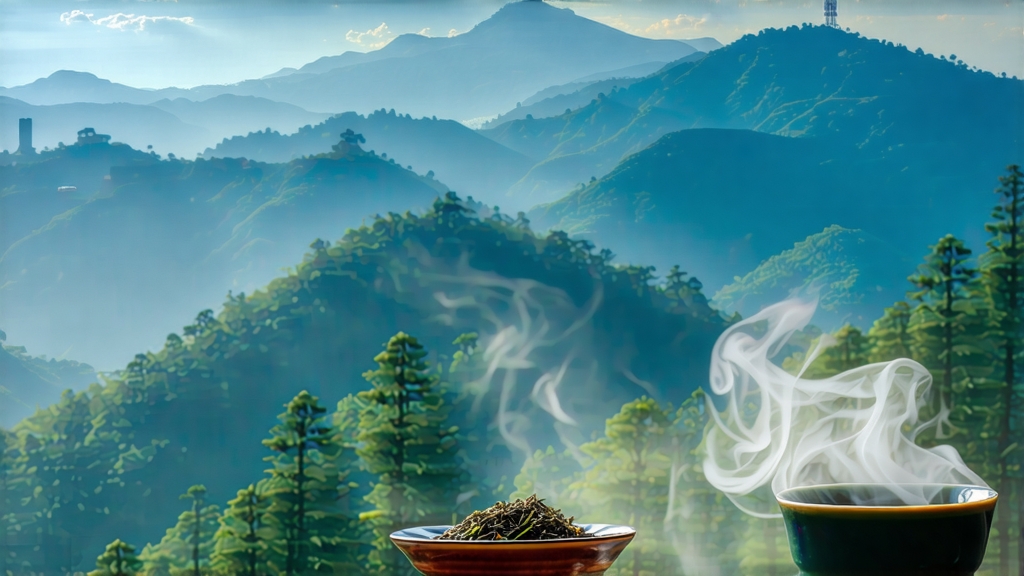
Long before English breakfast blends and afternoon tea services, there was Lapsang Souchong—an assertive, pine-smoked black tea that sprang from the granite cliffs of China’s Wuyi Mountains and quietly rewrote the global story of tea. Today the name evokes everything from campfire romance to polarizing tasting-room debates, yet its origin is humble: a 17th-century accident of logistics, military urgency, and the ingenuity of Songluo village farmers who needed to dry their tea before the marching armies arrived. To understand Lapsang Souchong is to understand how one small leaf can carry the fragrance of pine, the memory of trade winds, and the taste of history in a single sip.
Historical backdrop
Wuyi’s volcanic soil and subtropical mists have nurtured tea since the Tang dynasty, but Lapsang Souchong itself first appears in Qing-era shipping logs from the port of Xiamen, labeled “Bohea Souchong.” European merchants mistook “Bohea” (the Fujianese pronunciation of Wuyi) for a style rather than a place, and by 1669 the British East India Company was importing 40,000 pounds annually. The tea’s shelf-stable smokiness survived the six-month voyage around the Cape of Good Hope better than greener varieties, so it became the template for “black tea” in the Western imagination. When Scottish planters smuggled Chinese tea seeds and craftsmen to India in the 1840s, they carried with them the memory of Lapsang’s flavor, indirectly inspiring the malty Assams and muscatel Darjeelings that now dominate the market.
Terroir and leaf style
Authentic Lapsang Souchong comes only from Tongmu Guan, a protected enclave inside the Wuyi National Nature Reserve where pesticide use is forbidden and entry is restricted to residents. The cultivar of choice is Xiao Zhong (small-leaf) Qimen, a slow-growing bush that develops high concentrations of linalool and geraniol—floral precursors that balance smoke with natural sweetness. Spring picking begins when the first two leaves and a bud reach “sparrow’s tongue” size, usually around Qingming festival. Leaves destined for premium grades are harvested before 10 a.m., when mountain dew still glistens and enzymatic activity is gentle.
Crafting the smoke
Traditional manufacture follows five meticulous steps: withering, rolling, oxidizing, smoking, and firing. Fresh leaves are laid on bamboo screens inside wooden lofts above pine-fired hearths. A gentle current of cool smoke circulates for eight to ten hours, drying the leaf to 60 % moisture while impregnating it with resinous volatiles such as longifolene and guaiacol. Next comes rolling, done by hand in 3-kilogram batches; the ruptured cells turn amber within minutes, releasing a fragrance reminiscent of apricot and cedar. Oxidation proceeds in humid pine-wood chambers kept at 26 °C for two hours—shorter than for most black teas—to preserve a touch of greenness that amplifies the finish. The critical smoking stage follows: the semi-dry leaves are placed on sieves suspended over a slow smolder of local Masson pine and cypress roots. The fire never flames; it sighs, allowing phenols to polymerize on the leaf surface without scorching it. Finally, a charcoal bake at 80 °C fixes the aroma and reduces moisture to 4 %, readying the tea for travel across oceans and decades.
Grades and style variations
Connoisseurs recognize three ascending grades. “Leaf Lapsang” consists of neat, jet-black strips with golden tips; the liquor is bright copper, the smoke subtle, lingering like incense in a temple courtyard. “Broken Lapsang,” produced for the Russian caravan trade, offers a stronger, tarry punch that stands up to samovar boiling and condensed milk. The rarest is “Wild Lapsang,” picked from feral bushes growing at 1,200 m among azaleas and rhododendrons; its smoke is woven with notes of honeyed orchid and mountain sage, a reflection of the surrounding biodiversity. In recent years, innovative Tongmu artisans have also created an unsmoked version called “Zheng Shan Xiao Zhong,” processed like a classic black tea but kept within the reserve boundaries. It delivers malt, dark cocoa, and a hint of longan, allowing drinkers to taste the ter